In my 20 years of woodworking, I have come across different sub-crafts within this profession. Spoon-carving is a niche that some people dedicate their entire lives to. Others shave a few blocks of whittling wood and make spoons to put on their resumes. But both types of people need to answer one question: which wood is best for me?
The best wood for spoon carving is Alder or Maple as they are usually close-grained, moisture-resistant, and non-toxic. For beginners, the wood needs to be easy to carve and should not have Janka hardness over 1000. Advanced carvers can work with any non-toxic and moisture-resistant wood.
In this article, you will learn more about specific types of wood that are ideal for spoon carving, how difficult it is to work with each one, and why it is best for wood spoons.
These best spoon-carving woods are:
- Alder
- Maple
- Birch
- Apple
- Cherry
- Plum
- Walnut
- Beech
- Pear
- Hornbeam
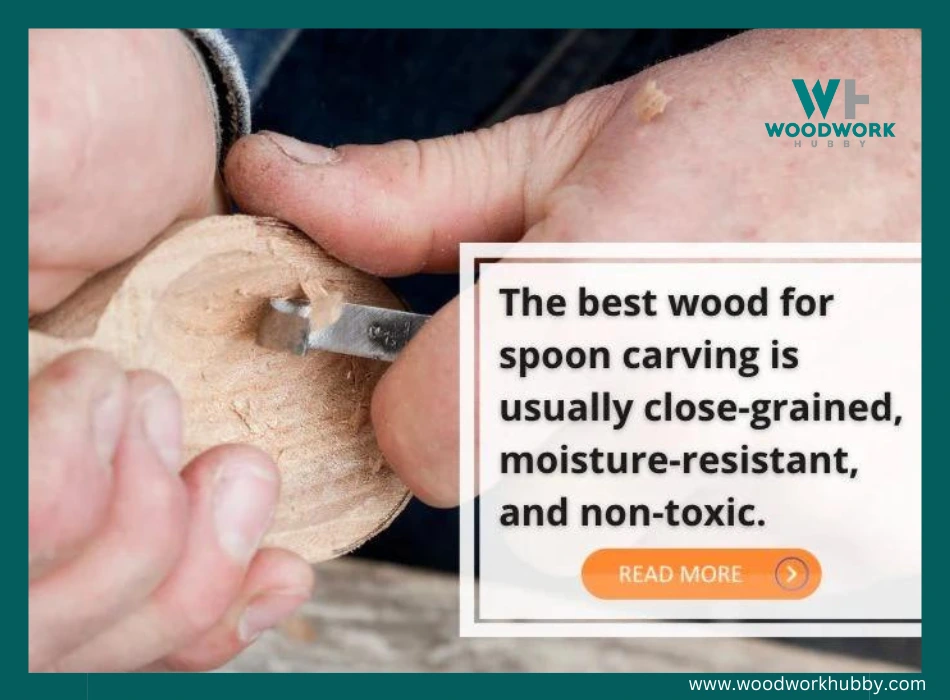
I have also put together this article to help you get started on some beginner wood carving projects.
Alder
Red Alder is an excellent wood for carving because it is relatively soft but not too soft. This resistance allows very precise carving. The straight grain of this wood, alongside its beautiful texture, produces a pleasant spoon that is almost like a work of art. Alder is relatively easy to carve with hand tools but can also be carved with power tools.
Maple
Maple can be considered a prestige wood in the spoon carving niche because it is not a common wood carving choice. Maple’s price isn’t as much a contributor to its status as a prestige wood as its difficulty in carving. When maple is used to make a spoon, it is obvious that effort has gone into the piece. Maple wood’s texture and its aesthetic grain pattern lend an admirable quality to the wood.
Birch
Birchwood is not used as often for spoon carving because it requires proper timing. Most woodworkers would rather have lumber in their sheds that they can get to whenever they feel like it.
Carving a birch spoon requires the Birch to be fresh and green. When Birch is soft, it can be carved with relative ease. After that, it tightens up and doesn’t soak as much water, becoming the perfect material for a kitchen utensil.
Apple
If you want your wooden spoon to look like an actual antique, then you must opt for apple wood. It retains its grain pattern and looks pretty punished even for a fresh product. That said, Applewood can be carved properly with power tools and sharp knives. Beginners might not enjoy this experience.
Cherry
Cherry Wood can be chipped into any shape. You can craft animals, birds, and of course, spoons with this hardwood. The result isn’t as smooth until you properly sand the project. But the aesthetic beauty of the cherry lumber is worth the extra effort.
Is Ash good for woodcarving? Click the link to see my article explaining if you can use it.
Plum
Plum is one of the most difficult woods to carve. It is even harder than Oak. A spoon made from plum wood is pretty durable. But beginners shouldn’t use this wood as a common whittling knife won’t work on it. It is better suited for power carving tools and wood turning. The resulting wood, however, is breathtaking. Sadly, people don’t use plum wood as often for spoon carving.
Walnut
Walnut is a prestige wood as it is expensive to acquire. It is not the best wood to carve spoons for beginners, but it is an excellent wood to carve spoons that sell. Since spoons made from walnut are rare and a testament to the skill of the woodworker, they are pretty popular among consumers. Some black walnut utensil sets go for $500.
Beechwood
Beechwood is good for hand carving and bad for chainsaw carving. Fortunately, spoons aren’t made with chainsaws. Spalted Beech specifically makes perfect spoons that have unique grain patterns created by the organic activity.
The wood is very hard, which can make carving challenging but precise. It is difficult to chip away parts you didn’t intend to remove, which is good for intermediate woodworkers.
Pear
Pear wood has a very high density, which is good for kitchen use. You don’t want wood that soaks up water, as it can rot easily. However, pear isn’t perfect for wood spoons just because of its hardness and density but also because of its aesthetic beauty. It can create well-textured spoons that are worthy of admiration, which they often get from customers who scoop them up with enthusiasm.
Hornbeam
Hornbeam is a pretty durable wood that can be used to make spoons with a light aesthetic. It features a very visible grain pattern, and its texture is pretty unique. This wood offers resistance and is one of the strongest woods used to carve utensils.
You will need power carving tools for this wood as it is hard enough to be named “ironwood.” But a spoon you carve from a block of Hornbeam will be a spoon that stands out in a good way.
Things To Know Before You Carve A Wood Spoon
A video showing step by step guide on how to carve a spoon.
Now that you know the 10 best woods for desirable spoons, you need to know a few things that will help you select one specific wood type that fits your goals. In this section, you will get some clarity on the metrics for wood selection.
- Know your goal – You’re either making wood spoons to sell or to use. In both instances, you have to decide between regular spoons (Birch, basswood, etc.) or elite spoons (Oak, Walnut, etc.).
- Know yourself – How much time have you spent carving? If you haven’t carved a spoon before, be kind to yourself and start with a material that’s easier to carve. You don’t want to get discouraged by an unnecessarily difficult challenge.
- Know the market – This is relevant only if you plan to sell your wooden spoon. If you want to sell it to wood spoon enthusiasts, then the less often wood is used for spoon carving, the more quickly it will sell. And if you want to sell to the regular woodcraft market, get cheap lumber because people won’t pay beyond a certain dollar amount.
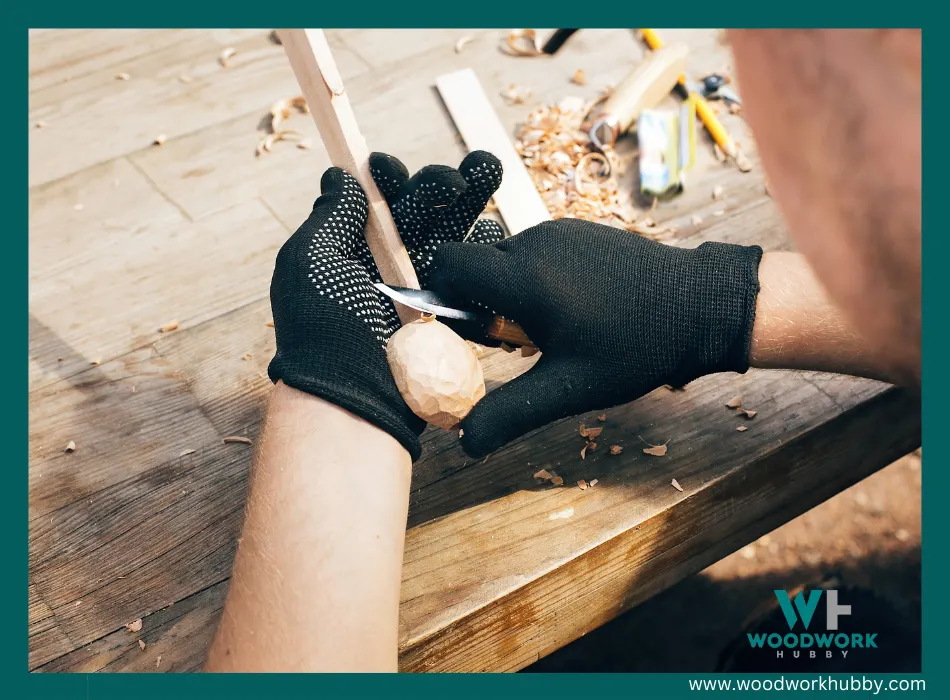
What Kind Of Wood Are Spoons Made From?
Spoons are usually made from carving wood since a block needs to be carved into a spoon. There are advanced spoon-making methods that can fashion spoons out of hardwoods as well. High-quality wood spoons are made from maple and beech. Bamboo spoons and birch spoons are also not uncommon.
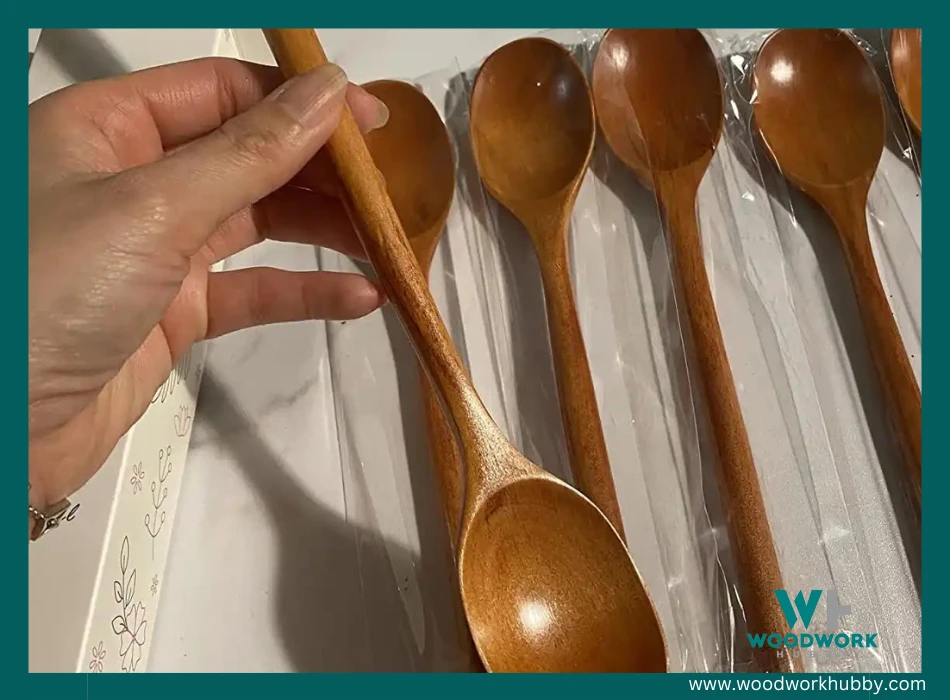
When you choose timber for your spoon, you need to consider your ideal customer. If your customers want a spoon that’s made from sustainable material, then a cheap material like pine is perfect. But if your customers want a long-lasting spoon, you’ll not only need a high-quality material like olive wood, but you’ll also need to finish it with a food-safe material.
What Is The Best Wood For Spoon Carving?
A video about choosing the best wood for spoon carving.
If you want to produce a high-quality wood spoon but are relatively new to the wood-carving practice, you should look for a material that is easy to carve, not too expensive to get, and durable once fashioned.
The best wood for spoon carving is Birch, as it is close-grained and doesn’t rot or incur water damage when used with wet food items. Basswood is the easier to carve spoons out of but requires better finishing.
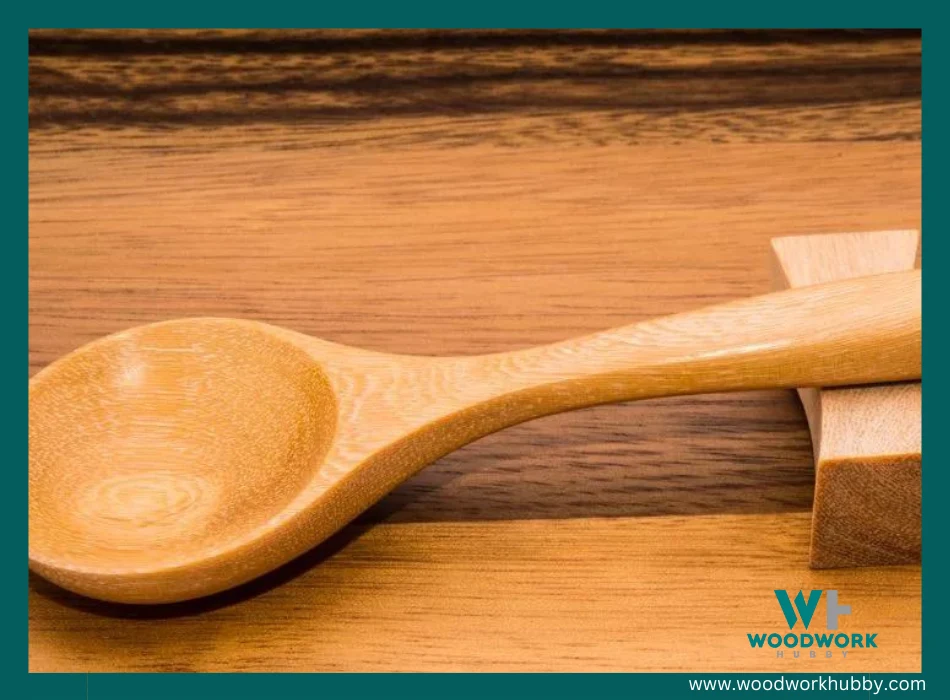
Fashioning spoons out of different wood materials can require different techniques. For instance, basswood spoons can be whittled out of dry basswood blocks. But when it comes to birch spoons, the best time to fashion them is while the wood is green and easy to shape. Once carved, the spoons become almost indestructible when the wood dries.
Is Birch Good For Spoon Carving?
As mentioned earlier, Birch is good for spoon carving, but you need to get your timing right. It is most conducive to carving when it is green. If the wood has been detached from the tree for a while, it might not be perfect for carving.
You can carve old birch timber and finish it with a food-safe coat. But this is relatively hard, and you have to be patient and willing to lose a few blocks until you get good at carving.
Once the product is ready, though, it is pretty good and can be beaten by prestige wood like Oak and Mahogany, though those spoons are even rarer.
Is Oak Good For Spoon Carving?
A video showing a spoon carved from red oak and then finished with ammonia fumes.
Oak is not a good wood for spoon carving because it is hard to carve. However, with woodturning or power-carving tools, Oak can be carved into high-end spoons that fetch a good price on the market. It is a prestige wood in this context and produces spoons that don’t get damaged easily.
There are two aspects that make wood great for spoon carving: how easy it is to carve and what kind of a spoon it would produce. Oak makes great spoons, but it is not easy to carve. If you start your spoon carving journey with Oak, you might get discouraged by your slow progress and might even decide that spoon carving is not for you.
Aside from picking a wood that is easy to carve and can last in a humid environment, you also need to make sure that the wood itself is non-toxic. Rosewood, Padauk, and Teak are woods that you should never use for cooking utensils.
What Woods Are Non-Toxic For Utensils?
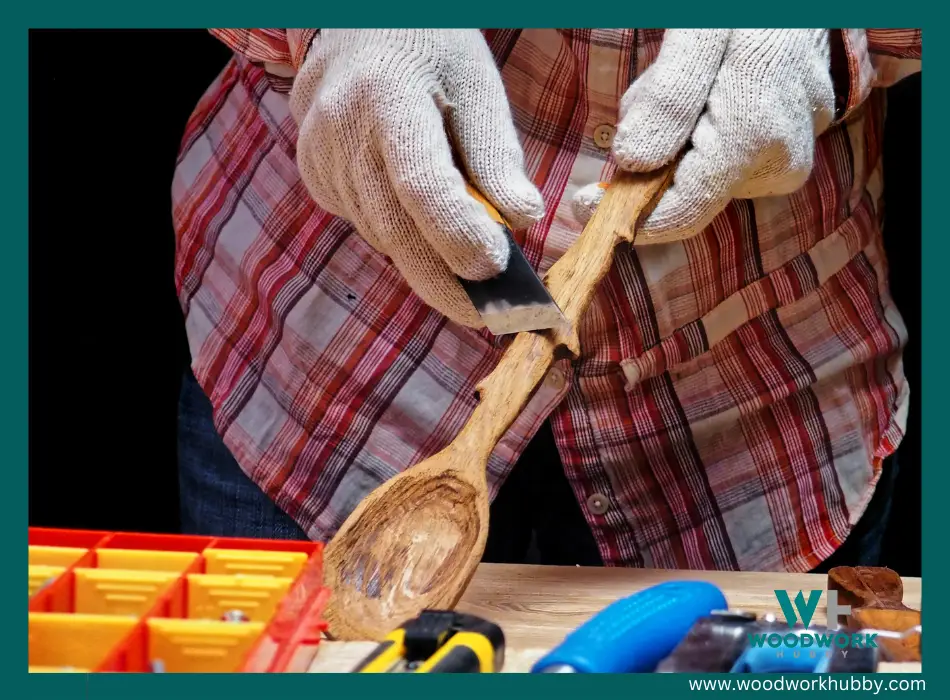
Generally, any wood that is marketed as a “spoon carving” wood is food-safe and is non-toxic for utensils. But for further surety, you can refer to the following table that covers the most common food-safe woods for utensils.
| Non-toxic Wood | Carving Difficulty |
|---|---|
| Basswood | Easy |
| Birch | Medium-level |
| Oak | Hard |
| Maple | Hard |
| Olive Wood | Hard |
| Apple Wood | Hard |
| Black Walnut | Medium |
| Black Cherry Wood | Medium |
| Bamboo | Medium |
Is Ashwood Good For Spoon Carving?
Ash wood has a high moisture content, which makes it suboptimal for spoon carving. Moreover, it is very hard, which makes carving difficult. Ashwood should not be used for any kitchen utensils. But if it is used, it must be finished with a film-building material that keeps it from soaking up water.
All in all, you can use Ashwood spoons, but making them is hard and maintaining them is also difficult. When easier alternatives exist, Ashwood must not be among your spoon-carving options. Advances wood carvers might craft ashwood spoons to hone their skills, but beginner carvers should stay away from this hardwood.
New carvers should work with timber that lends itself to kitchen utensil carving. These woods should be soft but firm and must have a grain that doesn’t soak up water.
Are Some Woods Better For Beginner Carvers?
Some wood is better for beginner carvers than others. That’s why almost all beginner whittling kits feature basswood. That’s also the reason most advanced carvers graduate to increasingly harder wood types. The following criteria can help you pick wood that will work for you as a beginner carver:
- Easy to shave – Carving involves etching and shaving. Any wood that is easy to shave is perfect for a beginner carver. That said, you must make an active effort not to get complacent with the same type of wood.
- Conducive to the project – If you’re carving a food-adjacent project like a plate, bowl, or spoon, you can’t use toxic wood. If you’re crafting something that will sit in the kitchen or the bathroom, the wood must not soak up water or have a very open grain. The wood might serve the project.
- Cheap to acquire – Finally, the wood you use for carving as a beginner must be very cheap. As the saying goes, practice makes perfect. And you need to practice a lot and run through a bunch of blocks before you can fashion beautiful spoons. Therefore, the wood must be cheap.
Have you ever wondered if Wood Carving is an Expensive Hobby? I wrote this article on it to help uncover the myths.
Final Thoughts – Best Wood for Spoon carving?
You should start spoon carving with wood that is easy to whittle, then graduate to harder wood that is generally used for wood chipping. You must begin with manual carving tools and then start using power tools. And that’s why I recommend using basswood, then alder, and eventually Oak and walnut for spoon carving.




